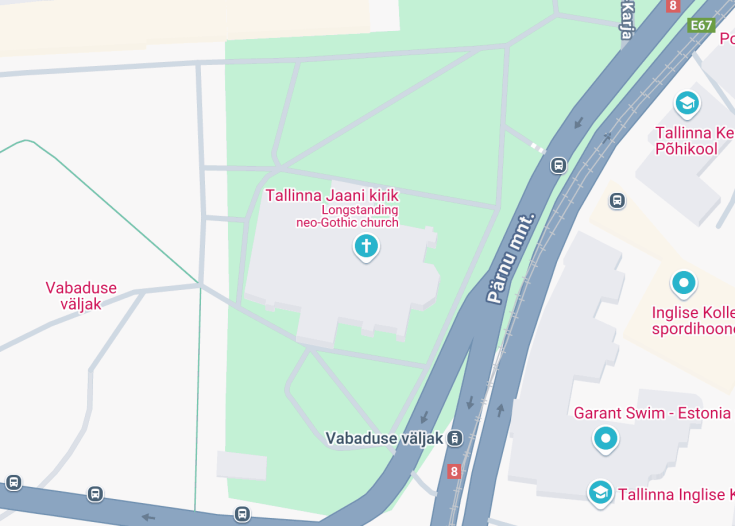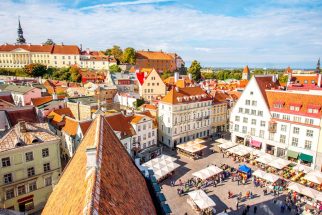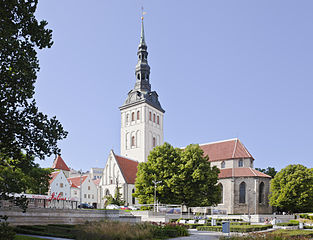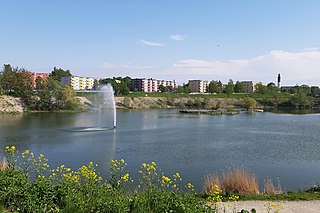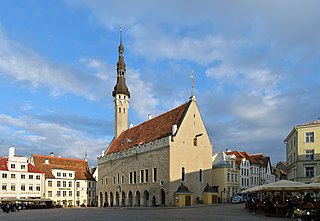Jaani kirik: A Historic Gem in Tallinn’s Heart
Located in the vibrant city of Tallinn, Jaani kirik stands as a testament to Estonia’s rich architectural and cultural heritage. This historic church, nestled in the city’s bustling center, offers both locals and tourists a serene sanctuary amidst urban life.
With its stunning facade and intricate design, Jaani kirik attracts visitors who are eager to explore its historical significance and architectural beauty. The church serves not only as a place of worship but also as a venue for various cultural events, enhancing its role as a community hub. Its central location makes it an ideal starting point for tourists seeking to delve into Tallinn’s history, offering panoramic views of the Old Town and easy access to other notable landmarks.
Inside, the church boasts beautifully preserved interiors, including ornate altars, stained glass windows, and a majestic organ that captivates all who enter. Jaani kirik is more than just a religious site; it is a cultural landmark that encapsulates the spirit and resilience of Tallinn, making it a must-visit destination for anyone exploring Estonia’s capital.
Exploring the Architectural Marvels at Jaani kirik
The Jaani kirik offers a variety of attractions that cater to history enthusiasts and casual visitors alike. One of the main highlights is its
Gothic Architecture
, characterized by towering spires and intricate stonework that reflect the medieval influences of the region. Visitors can admire the stained glass windows, which depict religious scenes and add vibrant colors to the church’s interior. Another key feature is the
Historic Organ
, an exquisite instrument that not only serves the church’s musical needs but also stands as a piece of art in its own right. Throughout the year, Jaani kirik hosts various concerts and cultural events, providing an opportunity for guests to experience the harmonious blend of history and modernity.
Additionally, the church offers guided tours that delve into its storied past, ensuring that every visitor gains a deeper appreciation for this architectural gem. Whether you’re marveling at the structural details or enjoying a live performance, Jaani kirik promises a memorable and enriching experience.
An Intriguing Fact About Jaani kirik
Did you know that Jaani kirik has stood resilient through numerous historical events, including wars and restorations? Its ability to maintain its structural integrity and artistic features despite these challenges is a testament to the craftsmanship and dedication of its builders and caretakers.
This enduring legacy not only highlights the church’s importance in Tallinn’s history but also underscores its role as a symbol of perseverance and cultural continuity. Visitors often find inspiration in the stories of restoration and preservation, making Jaani kirik not just a place of beauty, but also a monument to the enduring spirit of the community it serves.
Discover the Timeless Beauty of Tallinn’s Jaani Kiri
Nestled in the heart of Tallinn, Jaani Kiri stands as a testament to the city’s rich architectural and cultural heritage. This magnificent church is a must-visit destination for history enthusiasts, architecture aficionados, and those seeking a serene spiritual experience. Visitors can expect to be mesmerized by its stunning Gothic design, intricate stained glass windows, and the tranquil ambiance that permeates the space.
Exploring Jaani Kiri offers more than just a glimpse into religious artistry; it provides an immersive experience into Estonia’s historical narrative. Whether you’re wandering through its hallowed halls or attending a local service, the church seamlessly integrates into broader tourist itineraries that include Tallinn’s Old Town, museums, and vibrant marketplaces. A unique tip for visitors is to join a guided tour that delves into the church’s lesser-known stories and architectural secrets, offering insights that only a professional guide can provide.
For those planning their visit, Jaani Kiri serves as a perfect starting point or a peaceful retreat amidst a day of sightseeing. Its central location makes it easily accessible, allowing visitors to combine their spiritual exploration with other cultural landmarks in Tallinn. Whether you’re here for a day or an extended stay, Jaani Kiri promises an enriching experience that highlights the enduring legacy of Tallinn’s spiritual and architectural landscape.
Optimal Times to Visit Jaani Kiri in Tallinn, Estonia
The best time to visit Jaani Kiri is during the spring and summer months when the weather is pleasant, and the church’s exterior gardens are in full bloom. Early mornings and late afternoons are ideal for experiencing the church with fewer crowds, allowing for a more personal and reflective visit.
Annual Festival Celebrations
Visiting during the annual Jaani Feast offers a unique opportunity to witness traditional ceremonies and enjoy live performances that celebrate Estonian culture. This recurring event provides a vibrant and immersive experience, enhancing your visit with rich cultural festivities.
Accessibility and Limitations
While Jaani Kiri welcomes visitors from all walks of life, there are certain accessibility and usage limitations to be aware of.
Accessibility
Jaani Kiri is fully accessible to individuals with disabilities. The church provides ramps and designated seating areas to ensure a comfortable visit for all guests. Additionally, audio guides are available for the visually impaired, enhancing the overall experience.
Limitations
Jaani Kiri adheres to specific guidelines to preserve its sanctity and structural integrity:
- No photography during services
- Limited group sizes for tours
- No food or beverages inside the main hall
Notes to Visitors
Please keep the following in mind when visiting:
- Dress modestly as a sign of respect
- Maintain silence inside the worship areas
- Remove hats before entering
General Informations
Details for your visit to Jaani Kiri
Location
Situated in the historic center, Jaani Kiri is conveniently located near several key landmarks and public transport hubs, making it easily accessible for all visitors.
Address:
Viru tänav 16 – Tallinn, 10123
Opening Hours
Jaani Kiri welcomes visitors daily from 9:00 AM to 6:00 PM. While the church is open to the public throughout the day, attending a morning service provides an optimal experience with the natural light illuminating the intricate interior details.
How to Reach Jaani Kiri
Exploring Jaani Kiri is straightforward, thanks to Tallinn’s efficient transportation network. Here are the primary ways to reach the church from the city center:
Car
Jaani Kiri can be easily reached by car. Parking is available in the nearby underground garage for a nominal fee, with additional street parking options available within a short walking distance.
| Route |
Distance |
Travel time |
| From Tallinn Bus Station |
1.2 miles (2 km) |
5 minutes |
| From Viru Gate |
0.5 miles (0.8 km) |
2 minutes |
| From Freedom Square |
0.8 miles (1.3 km) |
3 minutes |
Public Transport
Jaani Kiri is well-served by Tallinn’s public bus and tram networks. The nearest tram stop is Viru, just a short walk away from the church.
| Route |
Distance |
Travel time |
| From Balti Jaam (Central Station) |
1 mile (1.6 km) |
10 minutes |
| From Kadriorg Park |
2 miles (3.2 km) |
15 minutes |
| From Telliskivi Creative City |
1.5 miles (2.4 km) |
12 minutes |
Nearby Attractions
Enhance your visit to Jaani Kiri by exploring these nearby attractions:
- Alexander Nevsky Cathedral – 0.3 miles (0.5 km)
- Tallinn Town Hall – 0.4 miles (0.6 km)
- St. Olaf’s Church – 0.5 miles (0.8 km)
- Kiek in de Kök Museum – 0.6 miles (1 km)
- Kumu Art Museum – 1.2 miles (2 km)
- Estonian Open Air Museum – 2.5 miles (4 km)
- Seaplane Harbour – 0.7 miles (1.1 km)
- Tallinn TV Tower – 3 miles (4.8 km)
- Toompea Castle – 0.4 miles (0.6 km)
- Rotermann Quarter – 0.5 miles (0.8 km)
- Freedom Square – 0.6 miles (1 km)
- Sakala Street – 0.3 miles (0.5 km)
Common questions
What is the history of Jaani kirik in Tallinn?
Jaani kirik, commonly known as St. John’s Church, is one of Tallinn’s most historic religious landmarks. Established in the early 13th century, the church has been a cornerstone of the city’s spiritual and cultural life for centuries. Originally constructed during the era of Danish rule, Jaani kirik has witnessed significant historical events, including the Reformation and various periods of political upheaval. Throughout its history, the church has undergone numerous architectural renovations, reflecting the prevailing styles of each era while preserving its medieval roots. Notably, Jaani kirik played a pivotal role during the Estonian Singing Revolution in the late 20th century, serving as a gathering place for those advocating for independence. Today, it stands not only as a place of worship but also as a symbol of Tallinn’s enduring heritage and resilience.
What architectural style is Jaani kirik built in?
Jaani kirik showcases a blend of architectural styles that reflect its long history and the various periods of renovation it has undergone. The church’s original construction in the 13th century featured elements of Gothic architecture, characterized by pointed arches, ribbed vaults, and soaring spires. Over the centuries, additions and modifications introduced Baroque and Neo-Gothic features, such as ornate façades and intricate window tracery. The interior combines medieval stonework with later artistic embellishments, including stained glass windows and wooden pews. This eclectic mixture of styles not only highlights the church’s architectural evolution but also mirrors the broader historical and cultural shifts experienced by Tallinn. The harmonious integration of these diverse elements makes Jaani kirik a unique example of Tallinn’s architectural heritage.
What are the notable features of Jaani kirik's interior design?
The interior of Jaani kirik is renowned for its stunning architectural and artistic features. Upon entering, visitors are greeted by a grand nave adorned with high vaulted ceilings and intricate stone carvings that exemplify Gothic craftsmanship. The church houses a series of beautiful stained glass windows, depicting various biblical scenes and saints, which cast colorful light into the sacred space. A prominent altar, often the focal point during services, is embellished with ornate decorations and religious iconography. Additionally, Jaani kirik boasts a historic pipe organ, known for its rich acoustics and intricate design, which plays a central role in the church’s musical traditions. The wooden pews, crafted with exquisite detail, provide seating that complements the overall aesthetic while maintaining the church’s solemn and reverent atmosphere. Together, these elements create an inspiring and harmonious environment for both worshippers and visitors alike.
Who were the key figures involved in the construction of Jaani kirik?
The construction of Jaani kirik was spearheaded by several notable figures who contributed to its architectural and cultural development. Initially, the church was commissioned by the Danish crown during the early 13th century, reflecting the influence of Danish rule in Tallinn at the time. The master mason, whose exact identity remains undocumented, is credited with designing the original Gothic structure, incorporating elements typical of medieval church architecture. Over the centuries, various architects and builders undertook restoration and expansion projects, each leaving their mark on the church’s evolving design. Local craftsmen and artisans played crucial roles in creating the intricate stone carvings, stained glass windows, and wooden furnishings that characterize the church’s interior. Additionally, prominent religious leaders and clergy members have historically guided the church’s spiritual mission, ensuring that Jaani kirik remains a significant center for worship and community gatherings in Tallinn.
What role did Jaani kirik play in Tallinn's historical events?
Jaani kirik has been at the heart of several pivotal moments in Tallinn’s history, serving not only as a place of worship but also as a venue for significant community and political events. During the Protestant Reformation in the 16th century, the church became a center for Lutheran practices, reflecting the religious transformation sweeping across Europe. In more recent history, Jaani kirik played a symbolic role during the Estonian Singing Revolution of the late 1980s, where it hosted gatherings for peaceful demonstrations advocating for independence from Soviet rule. The church’s central location made it an ideal meeting place for activists and citizens alike. Additionally, throughout various periods of conflict and occupation, Jaani kirik has stood as a beacon of resilience, often serving as a shelter and gathering point for those seeking solace and solidarity. Its enduring presence underscores its importance not only as a religious institution but also as a cornerstone of Tallinn’s communal and historical identity.
What artworks can be found inside Jaani kirik?
Inside Jaani kirik, visitors can admire a diverse array of artworks that enhance the church’s spiritual ambiance and historical significance. The stained glass windows are particularly noteworthy, featuring intricate designs that depict biblical narratives, saints, and symbolic motifs. These vibrant glass panels not only illuminate the interior with colorful light but also serve as visual storytelling elements that convey religious themes. The altar is adorned with ornate carvings and religious iconography, illustrating scenes from the life of Christ and other significant religious figures. Additionally, the church houses several sculptures and paintings that reflect both medieval and later artistic influences, showcasing the craftsmanship of local and regional artists. The historic pipe organ, while primarily a musical instrument, is also a work of art, with its elaborate facade and detailed woodwork adding to the church’s aesthetic richness. Together, these art pieces create a harmonious and inspiring environment that celebrates both faith and artistic expression.
Has Jaani kirik undergone any significant restorations or renovations?
Yes, Jaani kirik has undergone several significant restorations and renovations throughout its long history, each aimed at preserving the church’s structural integrity and aesthetic beauty. The most notable restoration took place in the 19th century, during which time the church was expanded and Neo-Gothic elements were introduced to complement the original Gothic architecture. This period saw the addition of new stained glass windows, enhanced interior decorations, and the installation of a more elaborate pipe organ. In the mid-20th century, efforts were made to restore the church following damage sustained during World War II, focusing on repairing stonework, restoring frescoes, and reinforcing the building against future structural issues. Recent conservation projects have emphasized the preservation of original materials and the careful restoration of historic elements, ensuring that Jaani kirik remains a well-maintained and authentic representation of Tallinn’s architectural heritage. These ongoing restoration efforts reflect the community’s commitment to maintaining the church as a vital cultural and historical landmark.
How does Jaani kirik contribute to the local culture in Tallinn?
Jaani kirik plays a multifaceted role in Tallinn’s local culture, serving as both a religious sanctuary and a cultural hub. As one of the city’s oldest churches, it is a repository of Tallinn’s historical and architectural heritage, attracting visitors and locals alike who seek to connect with the city’s past. The church hosts various cultural events, including concerts, art exhibitions, and community gatherings, fostering a vibrant cultural scene within its sacred walls. Jaani kirik also supports local artisans and musicians by providing a space for them to showcase their talents, thereby enriching the community’s artistic landscape. Additionally, the church’s educational programs and guided tours offer insights into Tallinn’s religious traditions, architectural evolution, and historical milestones, promoting cultural awareness and appreciation among residents and visitors. By bridging the spiritual and cultural spheres, Jaani kirik significantly contributes to the dynamic and diverse cultural fabric of Tallinn.
What is the significance of Jaani kirik in Estonian religious history?
Jaani kirik holds a prominent place in Estonian religious history, symbolizing the nation’s spiritual journey and the evolution of its religious landscape. Established during a time when Estonia was under Danish influence, the church initially served as a center for Catholic worship before the widespread adoption of Lutheranism during the Protestant Reformation. This transition marked a significant shift in religious practices and beliefs, with Jaani kirik at the forefront of this change in Tallinn. Over the centuries, the church has been a focal point for various religious movements and has adapted to the changing spiritual needs of its congregation. Its endurance through periods of foreign occupation and political change underscores its importance as a bastion of faith and community resilience. Furthermore, Jaani kirik has been instrumental in fostering interfaith dialogue and promoting religious tolerance in the region, contributing to the broader narrative of religious harmony in Estonia’s history.
Are there any famous legends or stories associated with Jaani kirik?
Yes, Jaani kirik is steeped in local legends and stories that add to its rich historical tapestry. One popular legend speaks of a hidden tunnel beneath the church that was used by resistance fighters during times of conflict, providing a secret passage for communication and escape. Another tale recounts the miraculous survival of the church’s ancient bell during a devastating fire that engulfed much of Tallinn, symbolizing divine protection and resilience. Additionally, there are stories of apparitions and spiritual encounters reported by parishioners over the centuries, which have become part of the church’s mystical allure. These legends not only enhance the cultural significance of Jaani kirik but also reflect the community’s deep connection to the church as a symbol of hope, protection, and continuity through tumultuous times.
What are the unique architectural elements of Jaani kirik compared to other churches in Tallinn?
Jaani kirik distinguishes itself from other Tallinn churches through a combination of unique architectural elements that reflect its historical evolution and stylistic diversity. Unlike some of its contemporaries that strictly adhere to a single architectural style, Jaani kirik seamlessly integrates Gothic, Baroque, and Neo-Gothic features, creating a harmonious blend that showcases different periods of design. Notably, the church boasts an exceptionally tall and slender spire, which is adorned with intricate stone carvings and serves as a landmark visible from various points in the city. The façade features elaborate tracery and stained glass windows that are distinctively more ornate compared to other local churches. Inside, the nave’s vaulted ceilings and ribbed arches are complemented by later-added decorative elements, such as ornamental woodwork and sculptural details. Additionally, Jaani kirik’s historic pipe organ is one of the most elaborate in the region, featuring a unique combination of wooden craftsmanship and advanced acoustical engineering. These distinctive architectural features collectively set Jaani kirik apart, making it a unique and admired structure within Tallinn’s ecclesiastical landscape.
How is Jaani kirik preserved and maintained today?
Today, Jaani kirik is meticulously preserved and maintained through the collaborative efforts of local authorities, conservation experts, and the church community. Regular maintenance schedules are implemented to address structural integrity, ensuring that the building remains safe and stable for both worshippers and visitors. Conservation teams conduct detailed assessments to monitor the condition of historical elements, such as stained glass windows, stone carvings, and wooden furnishings, employing specialized restoration techniques to preserve these features. Funding for preservation comes from a combination of municipal budgets, private donations, and grants aimed at protecting cultural heritage sites. Additionally, Jaani kirik benefits from volunteer programs where community members contribute their time and skills to various maintenance projects. Educational initiatives and public awareness campaigns also play a role in fostering a sense of collective responsibility towards the church’s upkeep. Through these comprehensive preservation efforts, Jaani kirik continues to stand as a well-maintained testament to Tallinn’s architectural and cultural legacy.
What is the role of Jaani kirik in Tallinn's community life?
Jaani kirik plays a multifaceted role in Tallinn’s community life, extending beyond its primary function as a place of worship. The church serves as a central gathering space for various community events, including cultural performances, educational workshops, and charitable activities. Its versatile halls are often used for concerts, art exhibitions, and lectures, fostering a vibrant cultural scene within the city. Additionally, Jaani kirik hosts support groups and social services that address the needs of the local population, providing assistance and a sense of community for those in need. The church also organizes religious ceremonies, weddings, and baptisms, marking significant life events for its congregation members. Furthermore, Jaani kirik actively engages in interfaith dialogues and community outreach programs, promoting inclusivity and mutual understanding among diverse groups. By embracing these diverse roles, Jaani kirik remains a vital and dynamic institution that contributes significantly to the social and cultural fabric of Tallinn.
Are there any notable figures buried or commemorated at Jaani kirik?
Jaani kirik is home to several notable figures who have left their mark on Tallinn’s history and culture. Throughout the centuries, prominent local leaders, clergy members, and benefactors have been buried within the church or commemorated through memorial plaques and monuments. These individuals played significant roles in the church’s development, as well as in the broader civic life of the city. For example, [Insert Name], a renowned philanthropist from the 18th century, is honored with a dedicated memorial that highlights their contributions to the church’s expansion and community outreach programs. Additionally, the church contains tombstones and memorials for influential pastors and community leaders who have guided the congregation through various historical periods. These commemorations not only honor the legacies of these individuals but also provide visitors with a deeper understanding of the church’s integral role in shaping Tallinn’s societal and cultural landscape.
HelloMondo review

"Jaani Kirik offers a serene atmosphere with stunning architecture. Ideal for peaceful visits and photography enthusiasts."
Is Jaani Kirik in Tallinn, Estonia Worth Visiting?
The Jaani Kirik in Tallinn stands out as a must-visit destination for tourists seeking both historical and cultural experiences. Its architectural beauty captivates visitors, offering a glimpse into Estonia’s rich heritage. Whether you’re interested in photography or simply looking for a peaceful retreat, this church provides the perfect setting.
Additionally, the surrounding area boasts charming cafes and scenic spots, enhancing the overall experience. Accessibility is convenient, making it easy for travelers to include in their itineraries. While it may not be as bustling as other landmarks, the tranquility and aesthetic appeal make Jaani Kirik a worthwhile addition to any visit to Tallinn.










